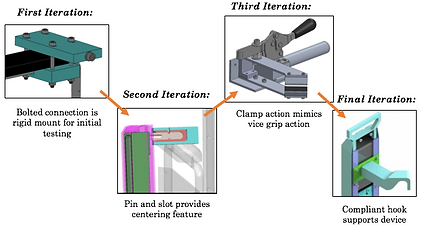top of page

Power-Assist Wheelchair Capstone Project
A device that quickly converts a manual wheelchair to a power-assisted one
DESCRIPTION
A device intended for a healthcare setting to reduce the load on wheelchair attendants that have to push patients all day long. It uses a quick-release 'claw' to grip the spokes of the wheel and apply a torque proportional to the attendants push
FEATURES


-
Quick installation
-
50% power assist on inclines
-
Drives by spokes
-
<10 lb.
-
Sleek design
-
Visible control indicators
-
Proportional power assist
-
Retains full wheelchair funciotnality
-
Reverse and overdrive safeguards
-
Emergency disengagement
-
No permanent hardware
-
Follows healthcare regulations
-
Full day battery
-
Modular design
-
Intuitive opperation
-
No interference with attendant or doorways
PROCESS
Problem Statement:
To create a rapidly-deployed device that reduces the force required to push a wheelchair in a healthcare setting.







Research:
-
Patent research: all expired
-
existing products: none in healthcare
-
Other uses of power-assist technology: skateboards, hover boards...
Ideation:
-
How can we reduce stress on nurse attendants?
-
Methods of applying power
-
Locations on the wheelchair
-
Combining existing ideas
-
Solving pain points of existing products
-
Focus on quick release and ease of use
Power Requirement:
-
Analytical calculations
-
Optimized variables
-
Confirmed in testing

Phase 1 CAD Design:
-
Simple block structure
-
Minimal features
-
For testing basic functionality
Iterative component design:
-
Armrest clamp Hook
-
Structural channel Plastic housing
-
Spoke clamps Spring loaded wedges
-
Basic drivetrain Flywheel and needle bearing
-
On/off Controls Added sensors and indicators
Component Analysis and Optimization:



Final Design





1st
place
-
Time and project management
-
Importance of backup plans
-
Turning concept into reality in short period of time
-
Sharing responsibilities within a leader-less team
-
Technical aspects of motor selection, drivetrain design, and controls
-
Optimizing designs with FEA
-
Presenting/selling ideas, progress, and reasonings
-
In depth market research
-
Machine shop practice
LEARNINGS
CHALLENGES
-
Tight timeline with many ongoing deliverables
-
Pivoting and overcoming continuous setbacks (regulations, market research, assembly issues, design oversights...)
-
Optimizing ease of installation and operation with functionality, cost, and timeline
-
Adding reverse and overdrive functionality
-
Accounting for tolerances between wheelchair dimensions
-
Control system for proportional power assist
-
Measuring value added/success
bottom of page